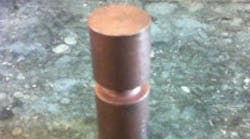REACTION VESSEL
Figure 1. Copper vial contained reactants as well as a copper milling ball. Source: University of Cincinnati.
Many processes used by industry handle far more solvent than reactants and products, which can cause significant purification and waste-disposal issues, he notes, contrasting this with the milling method: "We simply remove the product from the vial at the conclusion of the reaction. No other work-up [is] necessary." "Mechanochemistry can develop new reactions that we haven't seen before, saving on waste and developing new science," Mack believes. The researchers made triazoles using a copper milling ball instead of the traditional homogeneous copper catalyst; they milled the reactants inside a copper vial (
Figure 1). In one test, the vial was loaded with phenylacetylene and benzylazide; fifteen minutes of milling by the copper ball at ambient conditions produced 1-benzyl-4-phenyltriazole at greater-than-95% yield. A similar milling time produced high yields from a number of other azide substrates. Using balls instead of powder also eases catalyst recycle, state the researchers. More details appear in a recent article in
Green Chemistry.Work on additional syntheses and experiments using vials of other catalytic materials, including nickel, brass and molybdenum, are underway, says Mack. The team also is developing ways to increase the amount of energy generated by the mill, he notes."The process of vial catalysis is ripe for being scaled up and just needs chemical engineers to fine-tune the milling apparatus so it is made specifically for chemistry," Mack reckons, adding that his team is open to working with companies to further develop the technology.Meanwhile, researchers in the U.K. are extolling milling as a fast and environmentally friendly way to commercially produce metal organic frameworks (MOFs), crystalline nanomaterials that hold promise for storing and separating gases. See: "Milling Breaks Down Barriers for MOFs," www.ChemicalProcessing.com/articles/2013/milling-breaks-down-barriers-for-mofs/.
